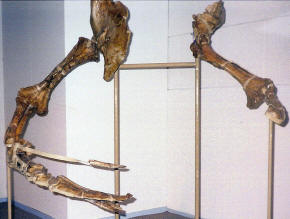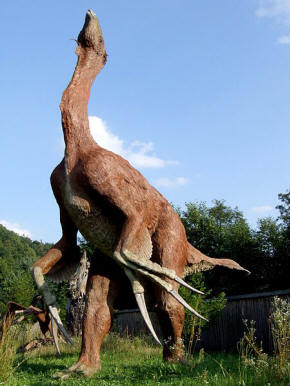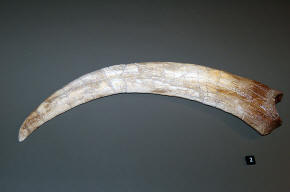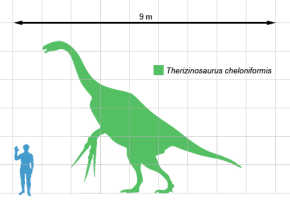Description
Therizinosaurs had a very
distinctive, often confusing set of characteristics. Their long necks, wide
torsos, and hind feet with four toes used in walking resembled
prosauropod dinosaurs.
Their unique hip bones, which pointed backwards and were partially fused
together, initially reminded paleontologists of the "bird-hipped"
ornithischians. Their
claws and hands, however, were most like the carnivorous theropods. Because
early finds were incomplete, this strange suite of anatomical features led
some scientists, such as
Gregory S. Paul, to conclude that segnosaurs
(Therizinosaurus
was not yet recognized as part of the group) represented a late-surviving
suborder of primitive dinosaurs, sometimes thought of as intermediates
between prosauropods and ornithischians. Because of their suspected
relationship with prosauropods, early depictions of segnosaurs (including
illustrations by Paul) portrayed them as semi-quadrupedal, a mode of
locomotion now known to have been impossible given the bird-like nature of
their wrists. It also led Paul to include segnosaurs within paleontologist
Robert T. Bakker's
Phytodinosauria in 1986, a superorder which was to include ornithischians,
prosauropods, and sauropods, typified by their "blunt, spoon-crowned teeth
suitable for cropping plants."
It was not until the mid-1990s,
after
Alxasaurus was
discovered and shown to possess more typically theropod features, and
Therizinosaurus was
recognized as a member of the segnosaur group, that their true identity as
herbivorous descendants of the carnivorous theropods became generally
accepted. The relation between the more derived therizinosaurids and other
theropods was greatly elucidated by the discovery of primitive members of
the group, such as
Beipiaosaurus in 1999 and
Falcarius in 2005. The scientists who
described Falcarius
noted that it seemed to represent an intermediate stage between carnivorous
and herbivorous theropods, a sort of "missing
link" between predatory maniraptorans and
plant-eating therizinosaurs. Although they are now classified as theropods,
therizinosaurs had skulls similar to those of
sauropods and the shape
of their teeth and jaws make it likely that they were herbivores.
Among the most striking
characteristics of therizinosaurs are the enormous claws on their hands,
which reached lengths of three feet in
Therizinosaurus. The unusual range of motion in
therizinosaur forelimbs, which allowed them to reach forward to a degree
other theropods could not achieve, also supports the idea that they were
mainly herbivorous. Therizinosaurs may have used their long reach and
strongly curved claws to grasp and shear leafy branches, in a manner similar
to the prehistoric
ground sloths.
Skin impressions from
Beipiaosaurus indicate
that therizinosaurs were covered with a coat of primitive, down-like
feathers similar to those seen in the
compsognathid
Sinosauropteryx, as
well as longer, simpler, quill-like feathers that may have been used in
display. Therizinosaurs spanned a large range of sizes, from the small
Beipiaosaurus
(which measured 2.2 m, or 7.3 ft in length), to the gigantic
Therizinosaurus, which at
an approximate 10–12 m (33–40 ft) long and an estimated weight of
6.2 tonnes, was among the
largest known theropods.
Therizinosaurus
Therizinosaurus
('scythe lizard', from the Greek therizo
meaning 'to reap' or 'to cut off' and sauros
meaning 'lizard') is a genus of very large theropod
dinosaur. Therizinosaurus
lived in the late Cretaceous
Period (late
Campanian-early
Maastrichtian stages, around 70 million
years ago), and was one of the last and largest representatives of its
unique group, the Therizinosauria. Its fossils were first discovered in
Mongolia and they were originally thought to belong to a turtle-like reptile
(hence the species name, T. cheloniformis
— "turtle-formed"). It is known only from a few bones, including gigantic
hand claws, from which it gets its name.
Discovery
and species
The first fossil remains of
Therizinosaurus were
discovered in the late 1940s by a joint Soviet-Mongolian fossil expedition,
in the
Nemegt Formation of
southwestern Mongolia. The expedition unearthed several giant claws that measured up
to a meter in length. These were described by Russian paleontologist
Evgeny Maleev in 1954, who thought they
belonged to a large, turtle-like reptile. However, it was not known what
creature these
 |
| Fossil Therizinosaurus arms from Mongolia, exhibited in
Experimentarium, Denmark (Picture
Source) |
belonged to until the early 1950s, when further expeditions unearthed more
fossils: several more sets of claws and parts of the fore and hind limbs.
Subsequent finds in northern China
allowed paleontologists to assemble the general skeletal structure of the
animal, which was determined to be a dinosaur and not a turtle.
The discovery that the enigmatic
segnosaurs (including
Erlikosaurus and
Segnosaurus) were actually theropods helped
clarify the relationships of Therizinosaurus.
Various theories had been proposed to explain the ancestry of the
"segnosaurids," with some scientists even suggesting they were descendants
of the
sauropodomorphs - but
new, well-preserved finds such as
Alxasaurus in 1993 and
Beipiaosaurus in 1996 provided details about
the bird-like pelvis, feet and skulls of primitive members, and helped
confirm that segnosaurids belonged to the same group of theropod dinosaurs
as Therizinosaurus
(and were therefore re-named therizinosaurids), and that therizinosaurs
were, more specifically, advanced, herbivorous
maniraptoran theropods.
Characteristics
Though the fossil remains of
Therizinosaurus are
incomplete, inferences can be made about its physical characteristics based on related therizinosaurids. Like
other members of its family, Therizinosaurus probably
had a small skull atop a long neck, with a bipedal gait and a
heavy, deep body (as evidenced by the wide pelvis of other
therizinosaurids). Its forelimbs may have reached a length of 2.5 meters
(8 ft) long. Its hind limbs ended in four weight-bearing toes, unlike other
theropod groups, in which the first toe was reduced to a
dewclaw.
The most distinctive feature of
Therizinosaurus was
the presence of three gigantic claws on each digit of its front limbs. These
were especially large in Therizinosaurus,
and while the largest claw specimens are incomplete, they probably reached
just under 1 meter (3.28 feet) in length.
Paleobiology
The feeding habits of
Therizinosaurus are
unknown, since no skull material has ever been found that could indicate its
diet. However, like other therizinosaurs, it was probably primarily
herbivorous.
There are multiple possible
functions that could have been served by the claws of
Therizinosaurus, such as
defense against predators (e.g. the contemporary
Tarbosaurus) and in intraspecific fighting,
such as fighting for territory or for mating, or to pull leafy tree branches
towards its mouth. The claws may even have served all these functions.
Return to the
Old Earth Ministries Online Dinosaur
Curriculum homepage.

Shopping
Bay
State Replicas - Claw
Black
Hills Institute - None
|



